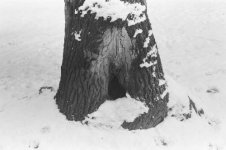- Forums
- Rangefinder Forum
- Image Processing: Darkroom / Lightroom / Film
- Film / Developing / Chemistry
You are using an out of date browser. It may not display this or other websites correctly.
You should upgrade or use an alternative browser.
You should upgrade or use an alternative browser.
Foma 200 and 400
- Thread starter Johnmcd
- Start date
- Latest activity Latest activity:
- Replies 101
- Views 25K
Nokton48
Veteran
Here is how I make replenisher using the Legacy Mic-X.
Works well for me.
Customers who wish to continue to replenish
MICRODOL-X Developer are encouraged to run their
own evaluation to determine
whether it will meet their
needs.
To make 3 U.S. quarts (2.84 litres) of replenishing
solution:
1. Start with approximately 2
U.S. quarts (2 litres) of
water at 90-100
°
F (32-38
°
C).
2. Add the contents of one packet of KODAK
MICRODOL-X Developer (size to make one U.S.
gallon—CAT No. 196 9724) with sufficient stirring
to keep the chemicals suspended.
3. Add 24 grams of photographic grade Sodium
Carbonate, monohydrate.
4. Mix until the components are dissolved.
5. Add water to bring the solution volume to 3.0 U.S.
quarts (2.84 litres).
6. Mix until the solution is uniform.
The mixed replenishing solution should be stored in full
tightly capped bottles until used. In partly full, tightly
stoppered bottles, a storage life of about two months
would be expected.
A starting point replenishment rate of 30 mL per roll of
135-36 exposure film (or equivalent) is suggested
Works well for me.
Customers who wish to continue to replenish
MICRODOL-X Developer are encouraged to run their
own evaluation to determine
whether it will meet their
needs.
To make 3 U.S. quarts (2.84 litres) of replenishing
solution:
1. Start with approximately 2
U.S. quarts (2 litres) of
water at 90-100
°
F (32-38
°
C).
2. Add the contents of one packet of KODAK
MICRODOL-X Developer (size to make one U.S.
gallon—CAT No. 196 9724) with sufficient stirring
to keep the chemicals suspended.
3. Add 24 grams of photographic grade Sodium
Carbonate, monohydrate.
4. Mix until the components are dissolved.
5. Add water to bring the solution volume to 3.0 U.S.
quarts (2.84 litres).
6. Mix until the solution is uniform.
The mixed replenishing solution should be stored in full
tightly capped bottles until used. In partly full, tightly
stoppered bottles, a storage life of about two months
would be expected.
A starting point replenishment rate of 30 mL per roll of
135-36 exposure film (or equivalent) is suggested
Fotohuis
Well-known
Here is how I make replenisher using the Legacy Mic-X.
Works well for me.
Customers who wish to continue to replenish
MICRODOL-X Developer are encouraged to run their
own evaluation to determine
whether it will meet their
needs.
To make 3 U.S. quarts (2.84 litres) of replenishing
solution:
That seems to be simple. 🙂
Nokton48
Veteran
Nokton48
Veteran
Nokton48
Veteran
Nokton48
Veteran
Microdol-X Formula:
For many years Micordol-X was the only developer I ever used, and was very happy with it. Then I got distracted by the exotic charms of Pyro developers only to tire of the hyper dilutions, and funny stains in my darkroom sink. So after an exhaustive Internet search I have come up with a formula for Microdon-X:
750ml Water
100 g Sodium Sulfite
5g Metol (You can use up to 7.5g if you like)
30 g Sodium Chloride (kosher table salt is just fine here)
2-3g Magnesium Sulphate (Epson Salts)
Water to make 1 litre
I have now used this formula, and it works best with Agfa-Pan, and other old style films, like Adox. With T-Max I have found a loss of about 1-1 1/2 stops of speed, and it makes things rather low in contrast. Here is a list of speeds that have worked for me:
Adox CHS 50--9 minutes
Agfa-Pan 100--8.5 minutes
T-Max 100 shot at 50--10 minutes
For many years Micordol-X was the only developer I ever used, and was very happy with it. Then I got distracted by the exotic charms of Pyro developers only to tire of the hyper dilutions, and funny stains in my darkroom sink. So after an exhaustive Internet search I have come up with a formula for Microdon-X:
750ml Water
100 g Sodium Sulfite
5g Metol (You can use up to 7.5g if you like)
30 g Sodium Chloride (kosher table salt is just fine here)
2-3g Magnesium Sulphate (Epson Salts)
Water to make 1 litre
I have now used this formula, and it works best with Agfa-Pan, and other old style films, like Adox. With T-Max I have found a loss of about 1-1 1/2 stops of speed, and it makes things rather low in contrast. Here is a list of speeds that have worked for me:
Adox CHS 50--9 minutes
Agfa-Pan 100--8.5 minutes
T-Max 100 shot at 50--10 minutes
Nokton48
Veteran
Another 180mm F2.8 Sonnar test.
Makiflex Standard, F2.8 @ 1/8 sec, camera on tripod.
Foma 200 6x9 rollfilm, Microdol-X
 Makiflex 180 Sonnar FOMA by Nokton48, on Flickr
Makiflex 180 Sonnar FOMA by Nokton48, on Flickr
Makiflex Standard, F2.8 @ 1/8 sec, camera on tripod.
Foma 200 6x9 rollfilm, Microdol-X
 Makiflex 180 Sonnar FOMA by Nokton48, on Flickr
Makiflex 180 Sonnar FOMA by Nokton48, on FlickrNokton48
Veteran
13Promet
Well-known
Highlights are severely blown out in this shot.
Depending on film, development or scan?
tho60
Well-known
Then the answer is to -increase- exposure. Try it and see what happens.
I almost always shoot an extra frame with 1 stop more. Often it's the best frame. Frequently I'm guessing at the exposure anyway with no meter
Too contrasty means too long development. Cut 20% and see what happens.
I only like soft-working developers with FOMA. Easy to get bulletproof negs
I have followed your advice. I rated both Fomapan 200 and 400 as ASA 50 film, and then I developed them in highly diluted Parodinal and Kalogen. The results were good with FP 200 and acceptable with 400. (135 format.) Winter oak: FP 200, Parodinal, post office: FP 400, Kalogen, 1:100 Dilution, 17 min, 20 C grade.
Attachments
Nokton48
Veteran
I have followed your advice. I rated both Fomapan 200 and 400 as ASA 50 film, and then I developed them in highly diluted Parodinal and Kalogen. The results were good with FP 200 and acceptable with 400. (135 format.) Winter oak: FP 200, Parodinal, post office: FP 400, Kalogen, 1:100 Dilution, 17 min, 20 C grade.
Glad it is starting to work for you. Make further adjustments if you feel you need to. Best thing is to "just try it"
tho60
Well-known
Glad it is starting to work for you. Make further adjustments if you feel you need to. Best thing is to "just try it"
Thank you very much for your help. However, there is no point in buying these films (Fomapan 200 and 400) if you can use them as ASA 50 film only. Rather I purchase Fomapan 100 film and develop it regularly, or I push it to ASA 400. See my other thread: http://www.rangefinderforum.com/forums/showthread.php?t=153973
Fomapan 200 pulled two stops showed distinct grey tones with moderate grain, but Fomapan 400 was very grainy even rated at 50 ASA. These features can applied as deliberate artistic factor, but for general purpose I will stay with Fomapan 100.
Idamia
Newbie
This is FP200 (E.I. 200) developed in Adonal 1:100 (60min stand).
6x4.5 format.

6x4.5 format.

Hogarth Ferguson
Well-known
I just got some Foma 200, and I strictly use DDX, so gonna give that a try. Looking forward to it.
p.giannakis
Pan Giannakis
Fomapan 200, rated at 160 in HC-110 for 7 minutes, dilution H.


robertofollia
Established
- Local time
- 10:54 AM
- Joined
- May 11, 2007
- Messages
- 109
Don't know if this is the correct place but, since almost 1 year ago I began shooting Foma 200.
Love the results, very classic, but what I like most it that the film base not only is very strong, but also is somewhat thinner than most other films.
As I buy it in bulk, it results that I can produce a 42+ exposures in every reloadable plastic film canister and last time 48 exp in a metal film canister, which is very convenient, especially in modern times, as finding films when you 're out is getting harder as the months go by. And having 10 additional exposures in every film canister is really convenient.
Best regards
Love the results, very classic, but what I like most it that the film base not only is very strong, but also is somewhat thinner than most other films.
As I buy it in bulk, it results that I can produce a 42+ exposures in every reloadable plastic film canister and last time 48 exp in a metal film canister, which is very convenient, especially in modern times, as finding films when you 're out is getting harder as the months go by. And having 10 additional exposures in every film canister is really convenient.
Best regards
Fotohuis
Well-known
It is a regular 125um in the 35mm version. Indeed the FP 200 has the softest emulsion of the 5 FP films (FP100-200-320-400-R100). However it is a nice film in use:

FP200 in R09/Rodinal E.I. 125. M7+ Elmarit F/2,8-28mm + Y-Dark Heliopan filter.

FP200 in R09/Rodinal E.I. 125. M7+ Elmarit F/2,8-28mm + Y-Dark Heliopan filter.
Prest_400
Multiformat
I started to try Fomapan in 120 as in Europe it is the most economic film. An incentive was being gifted a Holga, for which I feel even Ilford film is luxurious. The 100 worked well with it on a sunny day and gave me great negs on HC110 Dil H, 10min.
Ran a couple rolls in my Fuji RF which seem quite contrastier, gotta print those yet.
Got a brick of 200 for summer and will try. I tend to shoot BW and a lower EI than box speed.
The base feels different and when loading I noticed the rolls unravel very easily. Still, theoretically PET is an excellent material for dimensional and archival stability and wonder why other manufacturers don't use it .
Sent from my iPhone using Tapatalk
Ran a couple rolls in my Fuji RF which seem quite contrastier, gotta print those yet.
Got a brick of 200 for summer and will try. I tend to shoot BW and a lower EI than box speed.
The base feels different and when loading I noticed the rolls unravel very easily. Still, theoretically PET is an excellent material for dimensional and archival stability and wonder why other manufacturers don't use it .
Sent from my iPhone using Tapatalk
charjohncarter
Veteran
I have used all three (100-200-400 Arista EDU ultras) and have been able to finally getting it trained, or maybe it trained me.
This one is expired 400 and I noticed a little increase in grain:
 AristaEDUultra400 HC-110h by John Carter, on Flickr
AristaEDUultra400 HC-110h by John Carter, on Flickr
This one was fresh 100, and it is to me classic old style B&W film:
 Arista EDU ultra 100- Arista Liquid developer by John Carter, on Flickr
Arista EDU ultra 100- Arista Liquid developer by John Carter, on Flickr
This one is expired 400 and I noticed a little increase in grain:
 AristaEDUultra400 HC-110h by John Carter, on Flickr
AristaEDUultra400 HC-110h by John Carter, on FlickrThis one was fresh 100, and it is to me classic old style B&W film:
 Arista EDU ultra 100- Arista Liquid developer by John Carter, on Flickr
Arista EDU ultra 100- Arista Liquid developer by John Carter, on FlickrSimilar threads
- Replies
- 49
- Views
- 6K
- Replies
- 14
- Views
- 3K
- Replies
- 28
- Views
- 5K
- Replies
- 8
- Views
- 2K








